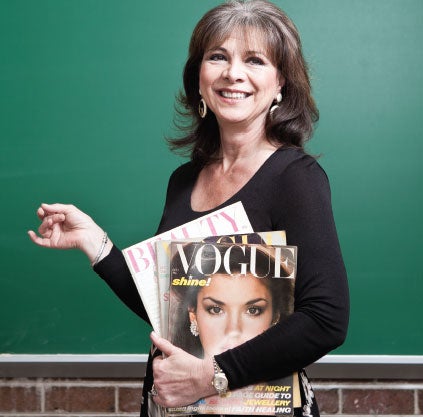Between the economy, global conflicts, technological advances, scientific discovery, the creative arts, cultural shifts, new vocabularies, a developing sense of self and a sliding socioeconomic scale, it’s a wonder anyone can keep up.
It’s an elusive thing, fashion. Heidi Klum’s been warning us about it for years: “One day you’re in, and the next, you’re out.” Considering you can have one foot on the catwalk and still get blindsided in the race down the runway, for those of us already fashionably late to the scene, it’s pretty much a lost cause. If fashion forward isn’t how your friends describe you, here’s all you need to know to keep up: Fashion is fickle.
It is, in the words of Miuccia Prada, “instant language” – something that can’t be studied or learned in the moment. It is so fleeting, so erratic, that it can only be understood in the retrospective context of all its cultural, political, social, practical, scientific and economic influences.
“Fashion is propelled by external forces,” says Glenda Byars ’75, an adjunct faculty member in the Department of Theatre and Dance, who last fall taught the first-year seminar The Good, the Bad and the Ugly: 20th-Century Fashion. “We’re telling the story of our 20th-century advances through a different prism – we’re using the language of fashion to tell the visual story of our history.”
Byars is no stranger to the fashion scene. She’s worked as a model, a photo-stylist, a makeup artist and – in the 1980s, the heyday of runway fashion – she was the fashion and public relations director for Saks Fifth Avenue, overseeing expensive runway shows involving over-the-top theatrics and celebrity. She returned to Charleston in the late 1990s to open the Saks on King Street, which has since been replaced by Forever 21.
“Fashion is a youth-oriented industry, so it makes sense that it’s always changing. It has to stay young,” says Byars. “Everything in fashion has changed, other than change. That’s the one constant. I want my students to
have a greater appreciation for where fashion originates and why – and the effort it takes to stay relevant. I want them to discover a passion for learning the why: why things happen.”
Fashion, Byars explains, is always a response to something. For example, the flapper style of the roaring ’20s was a direct result of World War I.
“The world changed when all the men went away to war and women needed clothes they could move in. They couldn’t mess with that corset anymore,” says Byars. “Women had done men’s jobs, and they had money to buy their own cigarettes, their own dresses. They became able to choose their own dress. The flapper was just rolling up in her economic time. This new ideal silhouette was also something of a girly protest to the voluptuous curves of Edwardian women.”
The textile industry also had an immense influence over fashion, with new fibers and fabrics allowing for the hitherto unheard of.
“Think about latex and nylon: They changed everything,” says Byars, explaining that, at the beginning of the 20th century, bathing suits were made from wool and, later, knit. “When vinyl came out, every designer had to do something with it, whether they should have or not. It just changes what is possible in fashion.”
As the textile industry evolved, so, too, did the cultural, political and social climates in the United States and around the world. And by the 1960s, the landscape was unrecognizable.
“The most cataclysmic shift was in the ’60s, because fashion was no longer dictated by the couturiers. It was an anti-establishment period, a protest period. It had that anti-authoritarian undercurrent that made street fashion bubble up as couture. True haute couture was coming to an end, and fashion became something accessible to everyone,” says Byars. “That was the last gasp of air in different social classes in terms of attire. It closed that gap – no one wanted to differentiate themselves as a higher class anymore.”
Since then, fashion has remained something for the masses – although, Byars notes, “we saw a resurgent opulence in the 1980s, until the stock market crash. And then comes grunge, which is this juxtaposition to the 1980s’ affluence. The pendulum must swing.”
As fashion and the fashion industry evolve, so, too, does cultural perspective.
“The technology boom really changed our point of view as a culture,” says Byars. “Technology makes things smaller, but it also makes things instant, even more fleeting.”
It also is highly individualized, a trend that (surprise, surprise) also carries over to fashion.
“Today, fashion is much more tribal than ever before – clothes are identifiers. They tell us who is part of our ‘clan.’ It’s become a subset of your culture – athletes, hipsters, professionals all have a fashion of their own,” says Byars. “You know where you belong. It gives us a tribal affiliation.
“It’s most obvious in theater,” she continues. “The costumer is responsible for making the characters identifiable. The costumer gives the visual signals that define the various characters. There’s a visual story there, and the costumer tells that story with clothing.”
It’s a universal language that we can all pick up on: The high-society lady, the maid, the professor all have their own look.
“I think theater makes it clear that fashion is the most effective form of nonverbal communication,” says Byars, noting: “Fashion and theater are both mirrors of society with a home address on the pulse of a time, place and attitude.”
Not to mention the politics, sciences, technologies and culture that are found there – at least for now, anyway.




